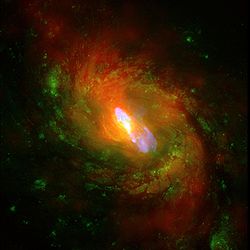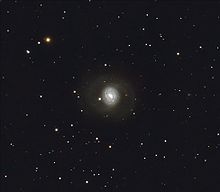- Messier 77
-
Cetus A 
Spiral Galaxy M77Observation data (J2000 epoch) Constellation Cetus Right ascension 2h 42m 40.7s[1] Declination -00° 00′ 48″[1] Redshift 1137 ± 3 km/s[1] Distance 47.0 Mly (14.4 Mpc)[2] Type (R)SA(rs)b[1] Apparent dimensions (V) 7′.1 × 6′.0[1] Apparent magnitude (V) 9.6[1] Notable features One of the biggest galaxies
of Messier's catalog.
Inclination estimated to be 40°.[2]Other designations Cetus A, M77, NGC 1068, UGC 2188, PGC 10266, Arp 37[1] See also: Galaxy, List of galaxies Messier 77 (also known as NGC 1068) is a barred spiral galaxy about 47 million light-years away in the constellation Cetus. Messier 77 is an active galaxy with an Active Galactic Nucleus (AGN), which is obscured from view by astronomical dust at visible wavelengths. The diameter of the molecular disk and hot plasma associated with the obscuring material was first measured at radio wavelengths by the VLBA and VLA. The hot dust around the nucleus was subsequently measured in the mid-infrared by the MIDI instrument at the VLTI. It is the brightest[3] Seyfert galaxy and is of type 2.[2]
Messier 77's diameter is 170,000 light-years.
Contents
History
Messier 77 was discovered by Pierre Méchain in 1780, who originally described it as a nebula. Méchain then communicated his discovery to Charles Messier, who subsequently listed the object in his catalog.[4] Both Messier and William Herschel described this galaxy as a star cluster.[4] Today, however, the object is known to be a galaxy.
X-ray source
X-ray source 1H 0244+001 in Cetus has been identified as Messier 77 (NGC 1068, M77).[5]
References
- ^ a b c d e f g "NASA/IPAC Extragalactic Database". Results for NGC 1068. http://nedwww.ipac.caltech.edu/. Retrieved 2006-11-18.
- ^ a b c R. J. Rand; J. F. Wallin (2004). "Pattern Speeds BIMA-SONG Galaxies with Molecule-Dominated ISMs Using the Tremaine-Weinberg Method". arXiv:astro-ph/0406426 [astro-ph].
- ^ de Vaucouleurs, Gérard (1973). "Southern Galaxies.VI. Luminosity Distribution in the Seyfert Galaxy NGC 1566". Astrophysical Journal 181: 31–50. Bibcode 1973ApJ...181...31D. doi:10.1086/152028.
- ^ a b K. G. Jones (1991). Messier's Nebulae and Star Clusters (2nd ed.). Cambridge University Press. ISBN 0-521-37079-5.
- ^ Wood KS, Meekins JF, Yentis DJ, Smathers HW, McNutt DP, Bleach RD (1984). "The HEAO A-1 X-ray source catalog". Astrophysical Journal Supplement Series 56 (12): 507–649. Bibcode 1984ApJS...56..507W. doi:10.1086/190992.
External links
- StarDate: M77 Fact Sheet
- Spiral Galaxy M77 @ SEDS Messier pages
- VLBA image of the month: radio continuum and water masers of NGC 1068
- Press release about VLTI observations of NGC 1068
- Messier 77 on WikiSky: DSS2, SDSS, GALEX, IRAS, Hydrogen α, X-Ray, Astrophoto, Sky Map, Articles and images
Astronomical catalogs Messier: M75 - M76 - M77 - M78 - M79 NGC: NGC 1066 - NGC 1067 - NGC 1068 - NGC 1069 - NGC 1070 PGC: PGC 10264 - PGC 10265 - PGC 10266 - PGC 10267 - PGC 10268 UGC: UGC 2186 - UGC 2187 - UGC 2188 - UGC 2189 - UGC 2190 Arp: Arp 35 - Arp 36 - Arp 37 - Arp 38 - Arp 39 Coordinates:
 02h 42m 40.7s, −00° 00′ 48″
02h 42m 40.7s, −00° 00′ 48″Messier objects List M1 · M2 · M3 · M4 · M5 · M6 · M7 · M8 · M9 · M10 · M11 · M12 · M13 · M14 · M15 · M16 · M17 · M18 · M19 · M20 · M21 · M22 · M23 · M24 · M25 · M26 · M27 · M28 · M29 · M30 · M31 · M32 · M33 · M34 · M35 · M36 · M37 · M38 · M39 · M40 · M41 · M42 · M43 · M44 · M45 · M46 · M47 · M48 · M49 · M50 · M51 · M52 · M53 · M54 · M55 · M56 · M57 · M58 · M59 · M60 · M61 · M62 · M63 · M64 · M65 · M66 · M67 · M68 · M69 · M70 · M71 · M72 · M73 · M74 · M75 · M76 · M77 · M78 · M79 · M80 · M81 · M82 · M83 · M84 · M85 · M86 · M87 · M88 · M89 · M90 · M91 · M92 · M93 · M94 · M95 · M96 · M97 · M98 · M99 · M100 · M101 · M102 · M103 · M104 · M105 · M106 · M107 · M108 · M109 · M110See also  Book:Messier objects ·
Book:Messier objects ·  Category:Messier objects
Category:Messier objects  Portal:AstronomyCategories:
Portal:AstronomyCategories:- Spiral galaxies
- Unbarred spiral galaxies
- Seyfert galaxies
- Cetus constellation
- Messier objects
- NGC objects
- UGC objects
- PGC objects
- Arp objects
Wikimedia Foundation. 2010.

